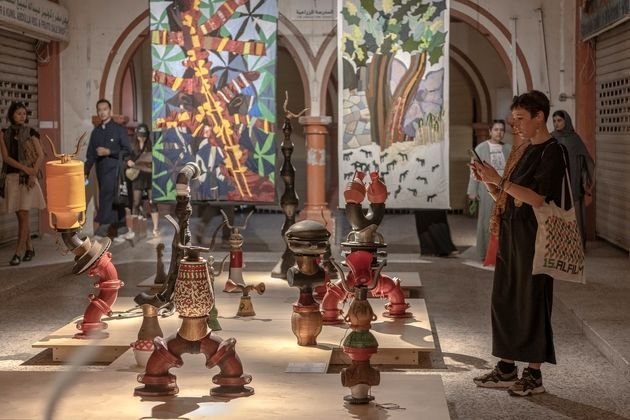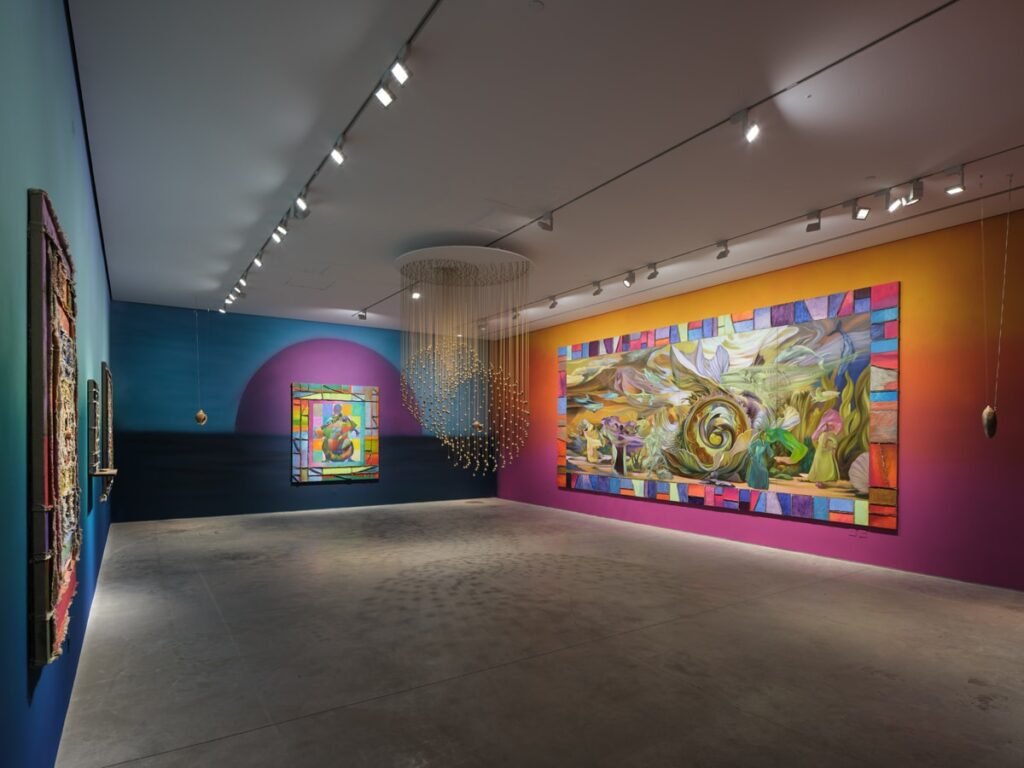Time is running out to witness one of the art world’s most ambitious and emotionally charged exhibitions. Sharjah Biennial 16 (SB16), themed “to carry,” is in its final days—and if you haven’t experienced it yet, now is the moment. With installations and performances that challenge, soothe, provoke, and inspire, this Biennial is a rare window into art that is deeply rooted in humanity.
Running across six towns in the Emirate of Sharjah, SB16 offers a once-in-a-lifetime experience. Whether you’re a long-time art lover or new to the world of contemporary creation, the work on display is universally compelling, grounded in lived realities, indigenous wisdom, cultural identity, environmental crisis, and decolonial imagination.
“To Carry”: A Curatorial Vision That Resonates
The guiding theme “to carry” explores the visible and invisible loads we bear: our identities, memories, wounds, and dreams. The Biennial’s five curators—Alia Swastika, Amal Khalaf, Megan Tamati-Quennell, Natasha Ginwala, and Zeynep Öz—bring a deeply personal and collective lens to this question. Each is steeped in curatorial practice that challenges the dominant narratives of the art world, giving the Biennial an introspective and decolonial edge.

The exhibitions are intentionally fragmented across spaces such as Sharjah’s old city, the Kalba Ice Factory, Al Madam’s desert ruins, and former schools and markets. The result? A layered, sensory, and sometimes emotional pilgrimage—both physically and mentally—that asks you not just to observe, but to engage and reflect.
A Platform for the Global South
Sharjah Biennial has long stood apart for spotlighting the Global South. Instead of art driven by the Western canon, SB16 honors stories and artists from Asia, Africa, South America, and the Indigenous worlds of Oceania and the Americas.

Over 150 artists and collectives bring stories of displacement, resistance, ecological grief, survival, community healing, and ancestral knowledge. It’s a mosaic of cultures, conversations, and critiques woven through every installation, performance, and screening.
Artworks You Shouldn’t Miss
Time is limited, but here are a few must-see works that are drawing widespread acclaim:
Stephanie Comilang – “Search for Life II”
Filmed between the UAE and the Philippines, this dual-screen projection immerses viewers in a futuristic narrative grounded in the lives of migrant workers and local pearl divers. It’s dreamy, visceral, and subtly radical in its storytelling.
Yhonnie Scarce – “Operation Buffalo”
Hailing from Australia, Scarce’s suspended glass sculptures—evocative of a toxic cloud—confront the legacy of nuclear testing on Aboriginal land. The beauty of the work is haunting, its message urgent.
Risham Syed – “Unn, Pani, Sut (Grain, Water, Truth)”
Wheat sacks, sounds of grinding, and soft installations create a gentle but potent commentary on sustenance, communal labor, and memory in Pakistan. It feels like standing in a dream woven from fields and stories.
Adelita Husni-Bey – “Like a Flood”
Using circular projection and poetic voiceovers, this work links climate disasters in Libya with Sharjah’s desert environment. It’s both analytical and deeply emotional, especially in the transformed Kalba Ice Factory venue.
Hugh Hayden – “Brier Patch”
Imagine school desks blooming with tree branches, set against a deserted school in Al Madam. This surreal intervention offers a powerful critique of education systems and cultural erasure.
Other stunning contributions include artists like Monira Al Qadiri, Rajni Perera, Megan Cope, and Claudia Martínez Garay, whose works revolve around hybrid identities, future imaginaries, and indigenous cosmologies.
More Than Just an Art Show

Sharjah Biennial is not confined to white-cube galleries. The event activates the entire emirate as a canvas. Expect to find exhibitions in unusual spaces—a vegetable market in Kalba, a reimagined fishing boat station, abandoned schools, and public spaces transformed into storytelling zones.
Alongside visual art, SB16 features an expansive public program, including:
- Performances blending music, dance, poetry, and activism
- Film screenings on ecology, migration, and memory
- Talks and workshops with artists and local communities
- Podcasts and online platforms that extend the Biennial’s reach globally
These programs serve to humanize and localize the event, making it an ever-evolving conversation between people, art, and place.
Why You Should Visit—Now
This Biennial isn’t just another art fair or museum showcase—it’s an experience that lingers long after you leave. Here’s why it’s worth your final trip:
1. A Rare Global South Showcase
While most global art events orbit around European or American institutions, SB16 proudly centers the Global South. It gives space to underrepresented voices, decentering colonial narratives in favor of empathy, heritage, and autonomy.
2. Unforgettable Sites
From coastal ruins to mountain pathways and market stalls, the Biennial’s locations alone are worth the journey. It’s a geography lesson wrapped in immersive, site-responsive art.
3. Free to All
The Biennial is free, accessible, and welcoming. You won’t need an exclusive pass or insider knowledge—just curiosity and openness.
4. A Human Connection
SB16 is built around themes that connect deeply to the human experience: grief, joy, migration, climate, memory, and collective care. These are not abstract concepts but living realities brought to life through powerful art.
Practical Tips for Visiting

- Event ends: June 15, 2025
- Venues to prioritize:
- Al Mureijah Art Spaces (Sharjah City)
- Kalba Ice Factory
- Al Dhaid House
- Al Madam Desert Site
- Getting around: Local taxis, car rentals, or organized shuttles between sites
- Plan ahead: Each venue takes 1–2 hours to explore thoroughly
- Essentials: Sunscreen, water, comfortable shoes, camera, and an open mind
What Happens After
Sharjah Biennial 16 will wrap up physically, but its themes—migration, memory, resilience—will continue to resonate in art circles, classrooms, and communities worldwide. Documentation, virtual tours, podcasts, and recorded talks will be accessible via the Sharjah Art Foundation website and affiliated platforms.
Last Words: Don’t Miss the Moment
Sharjah Biennial 16 is not just an art event—it’s a statement, a healing, and a gathering. It asks what we carry through life, through place, through history—and offers profound, sometimes uncomfortable, often beautiful answers.
As the final days approach, this is your chance to walk through those answers. Let the art speak, and let it stay with you. You’ll carry it far beyond Sharjah.
Do follow UAE Stories on Instagram
Read More: After 60 Years in UAE, Indian Educator Gets First Dubai Entry Stamp














